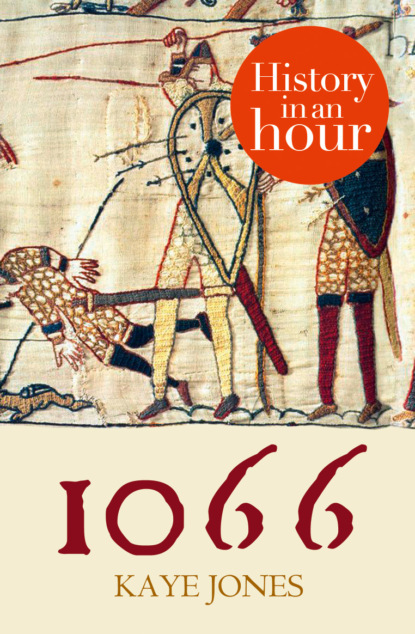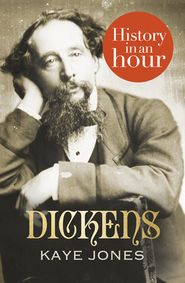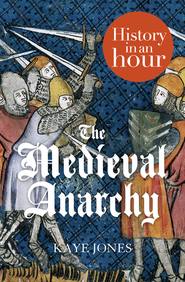По всем вопросам обращайтесь на: info@litportal.ru
(©) 2003-2024.
✖
1066: History in an Hour
Настройки чтения
Размер шрифта
Высота строк
Поля
1066: History in an Hour
Kaye Jones
Love history? Know your stuff with History in an Hour.During the year 1066, England had three different kings and fought three huge battles in defence of the realm, including the bloody Battle of Hastings. The result was the Norman Conquest which defined England during the Middle Ages.1066 in an Hour will guide you through the politics and personalities of the Norman invasion. It will help you understand why William the Conqueror was victorious and introduce you to the new king and subsequent ancestor to the Plantagenets and Tudors.Know your stuff: read about 1066 in just one hour.
1066
History in an Hour
Kaye Jones
About History in an Hour (#ulink_dd563245-086a-5308-97d9-7b616728db6b)
History in an Hour is a series of ebooks to help the reader learn the basic facts of a given subject area. Everything you need to know is presented in a straightforward narrative and in chronological order. No embedded links to divert your attention, nor a daunting book of 600 pages with a 35-page introduction. Just straight in, to the point, sixty minutes, done. Then, having absorbed the basics, you may feel inspired to explore further.
Give yourself sixty minutes and see what you can learn . . .
To find out more visit: http://historyinanhour.com or follow us on twitter: http://twitter.com/historyinanhour
Contents
Cover (#u6690ff08-dbb7-58f0-bdca-9b78a3bb6f30)
Title Page (#u68e23cc1-bb8f-5c10-b582-a4c2e4b3a98c)
About History in an Hour
Introduction
Background to 1066
April 1066: A Divine Omen?
The Norwegians
The Aftermath
A Conquered People
Appendix 1: Key Players
Appendix 2: Timeline
Copyright
Got Another Hour?
About the Publisher (#litres_trial_promo)
Introduction
This was a fatal day to England, and melancholy havoc was wrought in our dear country during the change of its lords.
William of Malmesbury on the Battle of Hastings
1066 is one of the most famous dates in English history. In those twelve months, England had three different kings and fought three bloody battles in defence of the realm and its people. The result was the Norman Conquest of England, an event which changed the country forever. This book will guide you through those turbulent months to understand the politics and personalities of that momentous year.
This, in an hour, is 1066.
Background to 1066
The year was 1051. King Edward the Confessor had been on the throne for nine years. So far, his reign had been peaceful and he had proven himself to be an able and successful monarch. Since 1045 Edward had been married to Edith, daughter of Earl Godwine, the most powerful nobleman in England. Despite a happy union, rumours abounded that their marriage had yet to be consummated. This created a potentially serious problem; who would succeed to the throne when Edward died?
Edward the Confessor
According to French writers, Edward had devised a solution to this problem; secure the succession by promising the throne to William, Duke of Normandy. The two men were distant cousins and William had visited Edward at his court in England some time in 1051. If William believed then that Edward’s promise would make him king of England, then the events of 1064 would only strengthen his resolve.
On his death in 1053, Earl Godwine’s authority in England passed to his sons, who became leading figures in English politics, ruling much of the nation’s territories. Again, as reported by French writers, King Edward sent Harold, the most powerful of these sons, to Normandy in 1064. If these writers are to be believed, the purpose of this trip was to confirm Edward’s succession promise made to William in 1051.
Harold’s journey to Normandy did not start well; he was shipwrecked north of Normandy, in the region of Ponthieu, and captured by the local count, Guy. According to the Bayeux Tapestry, William rushed to Harold’s rescue after hearing the news of his imprisonment. Harold then accompanied William into battle and was knighted. The Bayeux Tapestry, and other contemporary sources, recount that at William’s palace in Rouen, Harold swore an oath to the duke over holy relics. The exact words of this oath are not recorded, but contemporary writers were convinced that Harold promised to protect William’s claim to the throne and do all he could to ensure his succession. With the promise made, Harold returned to England.
Harold Godwinson, as depicted on the Bayeux Tapestry
January 1066: The Death of a King
King Edward had been sick since November, from what appears to have been a series of strokes. Despite a brief recovery, he fell ill again on Christmas Eve. Although he was able to attend the Christmas Day banquet, Edward’s illness caused him to miss the consecration of Westminster Abbey, his most famous project.
Although the king’s son was often chosen, it was not yet customary in England for the monarch to name his successor. This responsibility was left to the Witan, the king’s council of advisers, who were present while Edward lay dying. Choosing a new king was a serious business and, as Edward’s marriage had not produced a son, the Witan had developed a strict criterion to help them choose the best man for the job. First of all, the new king had to be an Englishman as the Witan did not want England to be ruled by a foreigner. Secondly, he must be of good character and, finally, be of royal blood. The king was free to nominate a successor but the final decision rested with the Witan.
The First Omen?
Shortly before his death on 4 or 5 January 1066, King Edward began to speak. He told those around him of a recent dream where two Norman monks he had once known recounted to him that God had placed a curse on England. One year and one day after Edward’s death, devils would bring fire, sword and war to punish the country for the wickedness of its earls and clergy. The curse would only be lifted when a green tree, felled halfway up its trunk and with one part cut off and taken three furlongs away, would rejoin and grow again.
Stigand, the Archbishop of Canterbury, dismissed his dream as the ravings of a man close to death but others began to worry. After all, Edward was an extremely pious man with a reputation for prophesying the future. But the dream was soon overshadowed by Edward’s next action. He offered his hand to Harold and placed the kingdom of England into his protection. After these important announcements, Edward fell back into a coma and died during the night of 4 January 1066.
The Witan Decide
On 5 January, the Witan unanimously confirmed Harold as the new king of England. Not only was he Edward’s choice but he was the most powerful man in England, of good character, a proven soldier and, above all, he was English. There was no mention of William and the alleged promise that was made in 1051, nor of Harold’s visit to Normandy in 1064.
Thus, on 6 January 1066, King Edward was buried in Westminster Abbey and Harold Godwinson was crowned King Harold II of England.
Edward the Confessor is buried at Westminster Abbey
The Contenders Emerge
Harold may have been crowned the king of England but, on hearing of King Edward’s death, there were other men ready to stake their claim. There was Harald Hardrada, king of Norway, who alleged that his father had been promised the English throne by King Edward’s predecessor, King Harthcnut. The young Edgar the Aetheling, a direct ancestor of King Alfred the Great, was another possible contender for the throne. And who could forget William? His claim rested on a distant blood connection to Edward and the alleged promised made in 1051 and renewed in 1064.
There was little doubt among the English that an invasion was imminent; England was a rich and bountiful country. For the claimants, the throne was a prize worth fighting for. At the forefront of Harold’s mind was the need to secure his position. A day or so after his coronation, Harold travelled to York in the north of his kingdom. There he married Eadgyth, the sister of the Earls of Northumbria and Mercia, Edwin and Morcar, and received oaths of fealty from the local nobility. Harold also began issuing coins bearing his likeness and inscribed with the word pax,meaning peace.
A coin issued by King Harold
Kaye Jones
Love history? Know your stuff with History in an Hour.During the year 1066, England had three different kings and fought three huge battles in defence of the realm, including the bloody Battle of Hastings. The result was the Norman Conquest which defined England during the Middle Ages.1066 in an Hour will guide you through the politics and personalities of the Norman invasion. It will help you understand why William the Conqueror was victorious and introduce you to the new king and subsequent ancestor to the Plantagenets and Tudors.Know your stuff: read about 1066 in just one hour.
1066
History in an Hour
Kaye Jones
About History in an Hour (#ulink_dd563245-086a-5308-97d9-7b616728db6b)
History in an Hour is a series of ebooks to help the reader learn the basic facts of a given subject area. Everything you need to know is presented in a straightforward narrative and in chronological order. No embedded links to divert your attention, nor a daunting book of 600 pages with a 35-page introduction. Just straight in, to the point, sixty minutes, done. Then, having absorbed the basics, you may feel inspired to explore further.
Give yourself sixty minutes and see what you can learn . . .
To find out more visit: http://historyinanhour.com or follow us on twitter: http://twitter.com/historyinanhour
Contents
Cover (#u6690ff08-dbb7-58f0-bdca-9b78a3bb6f30)
Title Page (#u68e23cc1-bb8f-5c10-b582-a4c2e4b3a98c)
About History in an Hour
Introduction
Background to 1066
April 1066: A Divine Omen?
The Norwegians
The Aftermath
A Conquered People
Appendix 1: Key Players
Appendix 2: Timeline
Copyright
Got Another Hour?
About the Publisher (#litres_trial_promo)
Introduction
This was a fatal day to England, and melancholy havoc was wrought in our dear country during the change of its lords.
William of Malmesbury on the Battle of Hastings
1066 is one of the most famous dates in English history. In those twelve months, England had three different kings and fought three bloody battles in defence of the realm and its people. The result was the Norman Conquest of England, an event which changed the country forever. This book will guide you through those turbulent months to understand the politics and personalities of that momentous year.
This, in an hour, is 1066.
Background to 1066
The year was 1051. King Edward the Confessor had been on the throne for nine years. So far, his reign had been peaceful and he had proven himself to be an able and successful monarch. Since 1045 Edward had been married to Edith, daughter of Earl Godwine, the most powerful nobleman in England. Despite a happy union, rumours abounded that their marriage had yet to be consummated. This created a potentially serious problem; who would succeed to the throne when Edward died?
Edward the Confessor
According to French writers, Edward had devised a solution to this problem; secure the succession by promising the throne to William, Duke of Normandy. The two men were distant cousins and William had visited Edward at his court in England some time in 1051. If William believed then that Edward’s promise would make him king of England, then the events of 1064 would only strengthen his resolve.
On his death in 1053, Earl Godwine’s authority in England passed to his sons, who became leading figures in English politics, ruling much of the nation’s territories. Again, as reported by French writers, King Edward sent Harold, the most powerful of these sons, to Normandy in 1064. If these writers are to be believed, the purpose of this trip was to confirm Edward’s succession promise made to William in 1051.
Harold’s journey to Normandy did not start well; he was shipwrecked north of Normandy, in the region of Ponthieu, and captured by the local count, Guy. According to the Bayeux Tapestry, William rushed to Harold’s rescue after hearing the news of his imprisonment. Harold then accompanied William into battle and was knighted. The Bayeux Tapestry, and other contemporary sources, recount that at William’s palace in Rouen, Harold swore an oath to the duke over holy relics. The exact words of this oath are not recorded, but contemporary writers were convinced that Harold promised to protect William’s claim to the throne and do all he could to ensure his succession. With the promise made, Harold returned to England.
Harold Godwinson, as depicted on the Bayeux Tapestry
January 1066: The Death of a King
King Edward had been sick since November, from what appears to have been a series of strokes. Despite a brief recovery, he fell ill again on Christmas Eve. Although he was able to attend the Christmas Day banquet, Edward’s illness caused him to miss the consecration of Westminster Abbey, his most famous project.
Although the king’s son was often chosen, it was not yet customary in England for the monarch to name his successor. This responsibility was left to the Witan, the king’s council of advisers, who were present while Edward lay dying. Choosing a new king was a serious business and, as Edward’s marriage had not produced a son, the Witan had developed a strict criterion to help them choose the best man for the job. First of all, the new king had to be an Englishman as the Witan did not want England to be ruled by a foreigner. Secondly, he must be of good character and, finally, be of royal blood. The king was free to nominate a successor but the final decision rested with the Witan.
The First Omen?
Shortly before his death on 4 or 5 January 1066, King Edward began to speak. He told those around him of a recent dream where two Norman monks he had once known recounted to him that God had placed a curse on England. One year and one day after Edward’s death, devils would bring fire, sword and war to punish the country for the wickedness of its earls and clergy. The curse would only be lifted when a green tree, felled halfway up its trunk and with one part cut off and taken three furlongs away, would rejoin and grow again.
Stigand, the Archbishop of Canterbury, dismissed his dream as the ravings of a man close to death but others began to worry. After all, Edward was an extremely pious man with a reputation for prophesying the future. But the dream was soon overshadowed by Edward’s next action. He offered his hand to Harold and placed the kingdom of England into his protection. After these important announcements, Edward fell back into a coma and died during the night of 4 January 1066.
The Witan Decide
On 5 January, the Witan unanimously confirmed Harold as the new king of England. Not only was he Edward’s choice but he was the most powerful man in England, of good character, a proven soldier and, above all, he was English. There was no mention of William and the alleged promise that was made in 1051, nor of Harold’s visit to Normandy in 1064.
Thus, on 6 January 1066, King Edward was buried in Westminster Abbey and Harold Godwinson was crowned King Harold II of England.
Edward the Confessor is buried at Westminster Abbey
The Contenders Emerge
Harold may have been crowned the king of England but, on hearing of King Edward’s death, there were other men ready to stake their claim. There was Harald Hardrada, king of Norway, who alleged that his father had been promised the English throne by King Edward’s predecessor, King Harthcnut. The young Edgar the Aetheling, a direct ancestor of King Alfred the Great, was another possible contender for the throne. And who could forget William? His claim rested on a distant blood connection to Edward and the alleged promised made in 1051 and renewed in 1064.
There was little doubt among the English that an invasion was imminent; England was a rich and bountiful country. For the claimants, the throne was a prize worth fighting for. At the forefront of Harold’s mind was the need to secure his position. A day or so after his coronation, Harold travelled to York in the north of his kingdom. There he married Eadgyth, the sister of the Earls of Northumbria and Mercia, Edwin and Morcar, and received oaths of fealty from the local nobility. Harold also began issuing coins bearing his likeness and inscribed with the word pax,meaning peace.
A coin issued by King Harold







